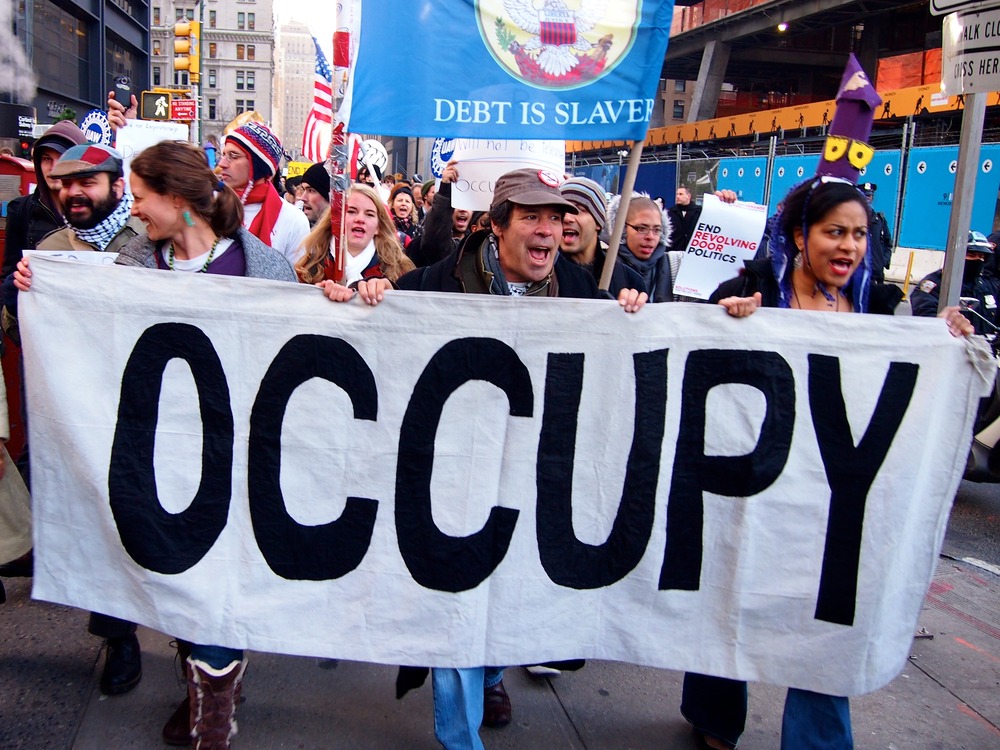
Spring 2013; Sociological Quarterly
“What did the nationwide series of fall 2011 encampments set in motion, and how is it being manifested today?”
“Where is this likely to lead in the next few years?”
“What ongoing movement activities—which may or may not carry the #Occupy label—can be traced back to the impetus of fall 2011?”
Sign up for our free newsletters
Subscribe to NPQ's newsletters to have our top stories delivered directly to your inbox.
By signing up, you agree to our privacy policy and terms of use, and to receive messages from NPQ and our partners.
These questions about the meaning and future of the Occupy Wall Street movement were posed to a number of activists and academics for the Spring issue of Sociological Quarterly. They were given four articles to review as starting points for their analysis, including one by this author in the Nonprofit Quarterly.
AlterNet writer Sarah Jaffe believes that Occupy’s long-run impact is that it undermined the notion that there is only one viable political and economic system—capitalism—and that alternate visions of future social, economic, and political forms were at least possible to imagine. But the tactical follow-up to the occupations has “not been…spectacular,” which she attributes in part to the police actions, with, Jaffe assets, “some of the most frightening displays of excessive police force ever seen in this country.” She describes a dynamic in the wake of the displaced occupations of “an overwhelming tendency to point out what Occupy did wrong…[some of which] from the more or less professional left—writers and professors and organizers whose relatively comfortable jobs Occupy threatened to make obsolete if it had actually ‘worked’ enough to really change the system.” Jaffe sees one response of the Occupy movement in spikes or peaks of movement activity. If the occupations were to be eventually displaced by police action, Occupiers would try other tactics, as shown by those working on Superstorm Sandy relief in New York and New Jersey; the Strike Debt group in New York fighting against student, mortgage, and credit card debt; and the Occupy Homes effort against foreclosures in Minnesota. These discrete, localized actions comprise the legacy of, according to Jaffe, “the work of tearing the mask of inevitability off the system and of creating a new one.”
Ruth Milkman, Penny Lewis, and Stephanie Luce of the City University of New York conducted a “convenience survey” of 25 Occupiers to get their personal perspectives on what they experienced. One interviewee said that he and perhaps others “were all expecting an occupation that would last maybe two days, and then the police would break it up. So we were not prepared for what was to come. We certainly didn’t expect it to expand to other locations, either.” As the occupation in Liberty Park gelled, so did the Occupiers, led largely by young people. Another interviewee observed, the organizers and activists “didn’t know better…That’s the brilliant thing about social movements and why they tend to be led by young people. They haven’t learned all the things that won’t work, and just get an audacious idea and move forward.” What made it work for the participants was the inclusiveness of what Occupy Wall Street stood for. By eschewing specific issues and demands, one Occupier suggested that “we could project onto Occupy what our issues were. An activist/journalist said that the lack of specific demands made it feasible to admit “anyone [to] come into the movement and see their grievance as equivalent to everyone else.” Life Jaffe’s observation that Occupy permitted the envisioning of an alternative to capitalism, these interviewees indicated that the inclusiveness was in part the reenvisioning, creating “a non-commodified space in the heart of global capital.”
UC Santa Barbara professor Richard Flacks recalled the days of the Port Huron Statement, the document that, 50 years ago, became the manifesto of Students for a Democratic Society (SDS). He noted that, for Occupy, “the incessant demand that the occupiers themselves issue policy statements, define their goals and direction, and map out strategies has been misplaced.” In his view, Occupy “was an effort to dramatize a deep and central issue—the way our lives are now being determined by a small group of financially super powerful institutions and persons,” not to issue some sort of all-encompassing political manifesto. Flacks views Occupy “not as a movement in itself but as one expression of a rising, and very long delayed, national and global class struggle.” Like Jaffe, he sees connections between the establishment of Occupy Wall Street and other protests, such as the Arab Spring, Chilean student protests, and student strikes in Quebec. What united the Occupiers wasn’t a shared political manifesto, but a “common target” and “shared enemy”—predatory financial power and institutions. He skips the question of “where is Occupy going” to address what he sees as a more important question, “can and how will people find ways to redistribute power and wealth in democratic directions?” Like Jaffe, he also cites discrete movement activities, such as people taking their money out of banks and putting them into credit unions, an emerging national student debt campaign, and innovative labor actions including the Chicago teachers strike and job actions at Wal-mart stores. Like Jaffe, he suggests that Occupy’s continuing legacy might be “modes of social organization beyond capitalism.”
Like the other authors, Marianne Manilov of the Engage Network (a component of the Movement Strategy Network) considers these and other Occupy spin-offs, reflecting “how much the core of the movement is about caring for people in need,” to be “pieces that are greater than the sum of their parts…components of what is emerging in Occupy [as] a longer-term effort aimed at systemic change.” Do you think that the post-occupation aspects of the Occupy movement are really greater than the sum of their parts?—Rick Cohen













